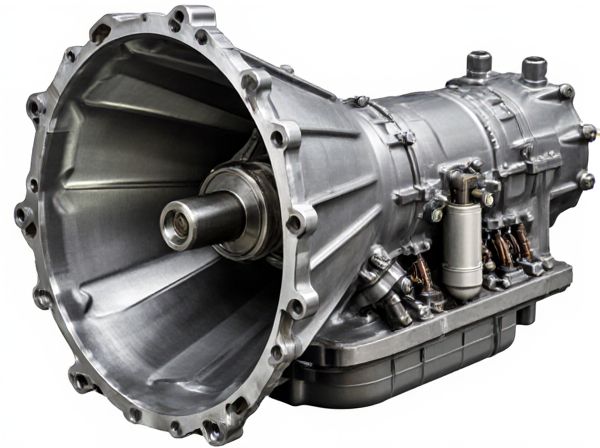
Photo illustration: Transaxle Transmission vs Conventional Transmission
A transaxle transmission combines the transmission and differential into a single unit, typically found in front-wheel-drive vehicles, offering compact design and improved weight distribution. Conventional transmissions are separate from the differential, commonly used in rear-wheel-drive setups, providing robust performance and easier maintenance. Understanding Your vehicle's drivetrain helps determine which transmission system optimally suits Your driving needs.
Table of Comparison
| Feature | Transaxle Transmission | Conventional Transmission |
|---|---|---|
| Design | Integrates transmission and differential in one unit | Separate transmission and differential components |
| Application | Common in front-wheel drive and some all-wheel drive vehicles | Typical in rear-wheel drive and some four-wheel drive vehicles |
| Weight & Size | Compact and lightweight, saving space | Larger and heavier, more spread out |
| Efficiency | Reduces drivetrain losses due to integrated design | Potentially higher drivetrain losses from separate units |
| Maintenance | Potentially higher cost due to integrated parts | Easier parts replacement and maintenance |
| Cost | Typically higher initial manufacturing cost | Generally lower manufacturing cost |
Introduction to Transaxle and Conventional Transmissions
Transaxle transmissions integrate the transmission and differential into a single compact unit, commonly used in front-wheel-drive vehicles to enhance space efficiency and reduce weight. Conventional transmissions separate the gearbox and differential, typically found in rear-wheel-drive cars, allowing for straightforward power distribution and easier maintenance. Each system offers distinct advantages in vehicle architecture, influencing drivetrain design and overall performance.
Defining Transaxle Transmission
A transaxle transmission combines the functions of the transmission, differential, and drive axle into a single integrated unit, commonly used in front-wheel-drive vehicles. This design optimizes space and weight distribution by consolidating components, improving fuel efficiency and handling. Unlike conventional transmissions that separate the transmission and differential, transaxles offer a compact, efficient drivetrain layout ideal for modern automotive engineering.
What is a Conventional Transmission?
A conventional transmission, also known as a manual or automatic gearbox, transfers engine power to the vehicle's wheels through a set of gears and shafts. It typically consists of a clutch or torque converter that manages power engagement, allowing smooth gear changes and efficient speed control. Conventional transmissions are widely used in various vehicles, offering reliable performance with distinct differences in operation compared to transaxle transmissions.
Key Differences Between Transaxle and Conventional Transmissions
Transaxle transmissions integrate the transmission, differential, and drive axle into a single compact unit, commonly used in front-wheel-drive vehicles to optimize space and reduce weight. Conventional transmissions separate the transmission and differential, typically found in rear-wheel-drive vehicles, allowing for distinct component placement and easier maintenance. Transaxles generally improve fuel efficiency and packaging efficiency, while conventional transmissions offer better handling and durability in performance applications.
Advantages of Transaxle Transmission
Transaxle transmissions combine the transmission and differential into a single, compact unit, resulting in reduced overall vehicle weight and increased efficiency. This integration improves fuel economy by minimizing power loss and enhances vehicle handling through optimized weight distribution, especially in front-wheel-drive configurations. The simplified design also lowers manufacturing costs and maintenance complexity compared to conventional transmissions.
Benefits of Conventional Transmission Systems
Conventional transmission systems offer superior control over gear selection and vehicle performance, making them ideal for drivers seeking a more engaging driving experience. These systems typically feature simpler mechanical designs, resulting in easier maintenance and lower repair costs compared to transaxle transmissions. Their robustness and reliability under heavy loads benefit vehicles designed for towing or off-road applications, providing consistent power delivery and durability.
Applications and Use Cases in Modern Vehicles
Transaxle transmissions integrate the transmission, differential, and drive axles into a single assembly, making them ideal for front-wheel-drive vehicles that prioritize compact design and weight reduction, commonly seen in passenger cars and hybrids. Conventional transmissions, often paired with a separate differential, suit rear-wheel-drive and heavy-duty vehicles, including trucks and performance sports cars, where robust torque handling and durability are essential. Modern electric and hybrid vehicles increasingly adopt transaxles to optimize space and efficiency, while traditional internal combustion engine vehicles still frequently use conventional transmissions for cost-effectiveness and mechanical simplicity.
Maintenance and Repair Considerations
Transaxle transmissions integrate the transmission and differential into a single compact assembly, reducing maintenance points but requiring specialized repair skills compared to conventional transmissions. Conventional transmissions, being separate units, offer easier access for routine maintenance such as fluid changes and repairs but may involve more frequent service intervals due to additional components. Repair costs for transaxle systems tend to be higher due to complexity, while conventional transmissions benefit from widespread mechanic familiarity and readily available parts.
Performance and Efficiency Comparison
Transaxle transmissions integrate the transmission and differential into a single compact unit, reducing weight and improving vehicle balance, which enhances overall performance and fuel efficiency. Conventional transmissions, typically separate from the differential, may add weight and complexity, potentially reducing efficiency but allowing for easier maintenance and repair. The transaxle design often results in smoother power delivery and better fuel economy, particularly in front-wheel-drive vehicles, compared to the traditional transmission setup.
Which Transmission is Right for Your Vehicle?
Choosing between a transaxle transmission and a conventional transmission depends on your vehicle's design and performance needs. Transaxle transmissions integrate the transmission, axle, and differential into one compact unit, ideal for front-wheel-drive cars and improving space and weight efficiency. Conventional transmissions, often used in rear-wheel-drive vehicles, separate the transmission and differential, offering durability and better handling for heavy-duty or performance applications.
 caratoz.com
caratoz.com